It is essentially illegal for American tourists to go to Cuba. This account is from my evil twin, who went to Cuba in December 1999. You can tell that it's not me because I, for instance, would never smoke. I also don't have a big, bushy beard.

|
It is essentially illegal for American tourists to go to Cuba. This account is from my evil twin, who went to Cuba in December 1999. You can tell that it's not me because I, for instance, would never smoke. I also don't have a big, bushy beard. |

|
Though this topic might not be of interest to most, I think it is important to know how money works in Cuba to understand everything else. Cuba uses pesos but recently legalized the circulation of U.S. dollars. In fact, they have fully embraced the dollar, printing their own dollar-equivalent, the "convertible peso", in addition to their moneda nacional, the peso cubano. These are printed because there is a "shortage" of U.S. dollars circulating in Cuba. Shops that sell stuff in pesos basically have nothing that any tourist would want. They feature half-empty shelves and big bottles of industrial-looking products like cleaners or paints. The dollar shops have all the clothes and export-quality goods and are well-stocked. Anything a tourist would possibly want is only available in dollars, even water and candy. Dollar shops also have better hours. I changed $10 into pesos, and I managed to spend it during my twenty-one day trip by buying lots of snacks and sandwiches from street vendors.
The exchange rate is approximately 21 pesos to the dollar. One convertible peso is exactly equivalent to one dollar. If you try to obtain dollars at a bank, you may be given a stack of convertible pesos, which is fine until you go back to your own country, where they are worthless. It is a little confusing to have three kinds of currency floating around, especially because all use the American dollar sign ($). Here, I only use the dollar sign to indicate U.S. dollars. Both pesos cubanos and convertible pesos are divided into 100 centavos. This makes the coins kind of confusing, as there is no indication if its value is in Cuban centavos or American cents, which are worth over twenty times more. After a day of buying things and accumulating change, it becomes clear which is which. If you buy something in a dollar shop, you will never get Cuban money as change. If you buy something in pesos, you will always get pesos as change. The convertible peso centavo coins are generally shiny silver coins that kind of resemble the American quarter, nickel, and dime. The peso cubano coins may be bronze or aluminum and are really worn. The only peso coins that were usually shiny and new were the Che Guevara three-peso coins, minted from 1990-1995.
I only have four data points for Cuban salaries. One dancer told me that she made $6 a month. A cigar roller may make about the same. A university professor about $14. A doctor $25. Health care and education are free, and they get some food rations, but not enough. Their cooking oil ration is tiny and the state stores often don't have any. So just in case you're wondering why there are these women hanging outside of discos willing to sleep with tourists if they'd pay the $2 cover charge to go dancing then take them shopping the next day, that's why. This is also the reason it is hard for schools to retain music and dance teachers when they can perform for tourists for dollar tips.
|
A frequent visitor of Cuba told me that people don't come to Cuba for the food or the toilets. You can find pretty reasonable food for under $20 (US), like at El Aljibe in Miramar, Habana, pictured on the right. You will only see tourists or diplomats at these places, as Cubans simply don't have $20 to blow on a meal. If you are wondering about the toilets remark, I think it's because they usually don't have seats or toilet paper outside of tourist-oriented places. | 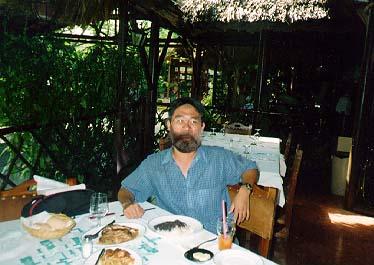
|

|
It is possible to eat more economically using pesos instead of dollars. The most common way to do this is to buy a "pizza" or sandwich on the streets for about 5 pesos. A pizza is a disk of dough about eight inches in diameter, smeared with a red sauce, sprinkled with something like cheese, and baked in anything that will hold embers, usually an oil drum. When they are done, they are folded in half and handed to you in a folded sheet of paper, which will burn your hand. I met one Canadian who was getting by on less than $10 a day by buying lots of 5-peso pizzas at once and putting them in a big plastic bag, consuming them throughout the day. I would not advise doing this unless you are truly out of money. |
To keep myself hydrated, I had to buy either bottled water (about $1 for a liter, not available for pesos) or beverages off the street in pesos. The most common option was the refresco, a sugary fruity drink, for a peso. In Pinar del Rio there were dozens of cola places, where you could get a tall glass of freshly-made (syrup poured straight into carbonated water) for less than a peso. Export quality rum was $3 for silver (unaged), $5 for 3-year-old, $8 for 5-year-old, and $10 for amazing 7-year old (Ron Matusalem is superb). Not a good way to stay hydrated, but it is a good way to be sociable, especially if you have a couple of disposable cups handy.
Peso restaurants do exist, but may not have too much in the way of a menu. In Viņales, I sat down with two Swedes in a little peso eatery and we ordered creole yellow rice and pasta, along with little cakes, cookies, and everything we could read off the menu. The yellow rice was just that, a small plate of rice that was yellow. The pasta was a little bowl of extremely pale, overcooked pasta with a bit of thin brownish sauce. I never had good cake in Cuba, and this was no exception. We enjoyed the cookie, which was basically sesame seeds in a flourless sugar matrix. I asked for my check, which came to less than 20 pesos (about one dollar American). When the Swedes wanted to pay, they were informed that I had paid for the three of us. So you can save money on food if you are not too fussy and don't require nutrients. This same restaurant sold fresh-squeezed orange juice for less than two pesos, and my tourist friend wanted to pay them with a convertible peso dime, but they refused to take it. Moneda nacional only, so I dug out the two pesos for him.
The funny thing about the peso places was how uniform the menus were in a given town. Most places only had one thing on the menu. In Pinar del Rio you got hamburguesas, which were little sausage-like patties on a bun possibly accompanied by a bit of tomato. Every peso restaurant here just sold hamburguesas, cigarettes, and alcohol. The street vendors sold identical-looking hamburguesas. A couple of times I ate in a particularly nice-looking tiled place with barstools from the 50's. On the counter in front of each stool was a plate. People would walk into a restaurant and hold up one or two fingers, and one or two hamburgers were placed on the plate in front of them. The plates never left their spots on the counter. Occasionally, a Cuban would bring in a plastic bag and ask for ten or more, and lots of hamburgers were dropped into the bag (fortunately, they are tiny, a bit dry, and have no toppings or condiments, so this is not as messy as it sounds). In Trinidad it was soft-serve ice cream, colas, and minutas, or little deep-fried fish on a bun with an optional dash of vinegary hot sauce. Remedios had pork sandwiches.
There is a sort of middle range where they charge two or three dollars for a meal, and you will see a few Cubans among the tourists eating at these places. The food is generally straight criollo - rice, beans, and fried chicken. Chinese restaurants (which are not common outside Habana Vieja) also charge around this amount.
A relatively new option is the paladar, which is a privately-run restaurant. The government recently allowed citizens to run private inns and restaurants for a hefty fee. The restaurants have a few odd restrictions to give the state-run restaurants an advantage - they can not have more than twelve tables and they can not serve seafood. The latter rule is not strictly-enforced, and paladares are usually the best place to get fish, shrimp, and langosta (lobster). Meals tend to be from $7-$10, and can range from generous portions of home-cooking to a full-blown fancy western-style restaurant dinner, like La Guardia in Habana. I am under the impression that it is hard for paladares to stay in business. One thing that I found puzzling was the frequency of "Chicken Cordon Bleu" or "Pollo Gordon Blue" or some other bastardization of the phrase on menus. I assume that ham and cheese are pretty much the only ingredients that chefs can consistently obtain, so this is the perfect dish.
Cubans love ice cream. I often got a cone of it on the streets for three pesos. Cuban ice cream seems to have a high water content, resulting in lots of ice crystals and fast melting times. However the flavors are good, and I think the high water content means lower fat content, allowing you to eat quite a lot to cool off on a hot day. By far the best place to eat ice cream in Cuba is in Parque Copelia, next to the Habana Libre Hotel in central Habana. It is a weird modern two-story building surrounded by a small park. There is a dollar section, which offers immediate service and longer hours, but it is much more fun to eat in the peso section. It is confusing and involves waiting in line for an hour, but you can watch all of Habana enjoying ice cream. There are multiple eating areas, each with its own line and menu.
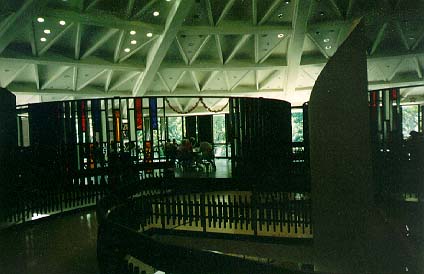
I think upstairs has the largest seating capacity and the longest line. The photo on the right is of the interior of the upstairs. It is full of small tables with four chairs each. When you sit down, you are given a glass of water gratis and asked for your order, which will be for a dish containing five scoops of ice cream costing 7 1/2 pesos. You may have a choice of flavors. You may not. Many Cubans ordered two dishes of ice cream, to the horror of onlooking tourists (who are kind of rare in the peso section). After eating a dish yourself, you can imagine that it is possible to eat two of them (ten scoops), as they are not high-fat super premium ice creams. After waiting in the hot Cuban sun for an hour to get in, you can see why people would order so much.
The downstairs section in the building is quite different. There is a large counter lined with fixed bar stools, which makes it look kind of like an American diner from the 60's. Come to think of it, it probably is from the 60's, as it has been almost impossible to remodel anything in Cuba since the embargo. You can order many different things, like sundaes and bits of cake. I just opted for the biggest thing I could find on the menu, which was five balls of ice cream. I was expecting to get exactly what I had gotten upstairs, but instead, I got four different flavors (I didn't even know they had that many in stock) and a choice of strawberry or chocolate topping. The ice cream was a bit cheaper here, only five pesos for my dish. The choice of flavors they have downstairs has no relationship to what they stock upstairs. They seem to have completely independent supplies of ice cream. There is also an outdoor peso section with little tables that seat four, but I couldn't find the line for it.
There are buses, trains, and taxis. I usually took buses. Cubans were charged in pesos, and tourists were charged the same amount, but in dollars. So a seven peso bus ride becomes a seven dollar bus ride. The prices were still reasonable. You can go across the entire island for less than $50. If you pay in dollars, you go to a special office in the terminal to get the ticket an hour before departure (they will not sell tickets before then), then they will shepherd you and the other tourists out to the bus when it arrives. If you manage to pay in pesos, you should probably get tickets in the morning and hope that there is a seat for you on the bus when it arrives. Like everything else in Cuba, you have to decide if you have time or money. If you don't mind missing the bus and having to stay in town for an extra day, you might do fine paying in pesos. I usually opted for the high-priced U.S. dollar route.
| The beautiful old mansions in the middle of Habana were divided into seemingly-arbitrary living areas so to accommodate dozens of families. Some of the families lived in rooms, while the larger spaces in the mansions were divided by bits of fencing and sheets suspended from the ceiling to allow multiple families to live there. La Guarida, a very popular paladar, is on the top floor of such a building. While walking up the marble steps, you can watch the lights of families having dinner through the sheets on the second floor. On the third floor landing I turned my camera away from the family quarters and towards the space where they had their laundry lines up. | 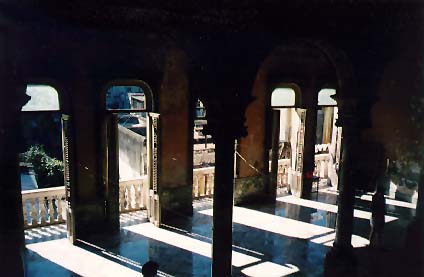
|
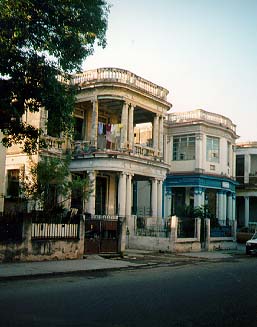
| There were many privately owned accommodations for tourists in Vedado, which is a bit west of the center of Habana. There were many large old homes and apartment buildings interspersed with many neighborhood shops and businesses. It is fairly quiet here. |
| I enjoyed walking through Centro Habana on my way to Habana Vieja from Vedado. The two roads I took were Calle Concordia and Calle Neptuno, both lined with buildings from the early twentieth century and showing their age. Habana seems to have a shortage of paint, and nowhere is it more evident than here and in Habana Vieja. I hear that it is safer to walk in the middle of the street, where the odds of getting hit by a falling balcony are much lower. | 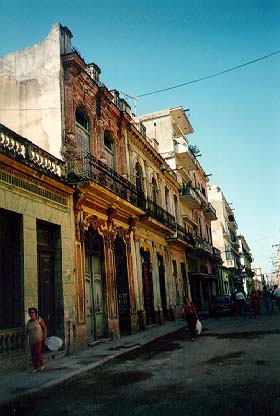
|
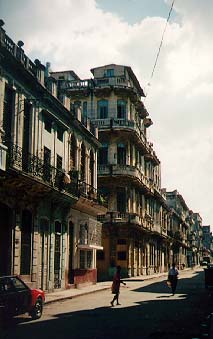
| Habana Vieja is where many of the tourist attractions are. Hemingway fans can visit his favorite bars and his old room in the Hotel Ambos Mundos. This area is where you can buy crappy souvineers. You can also visit the Benetton, which may be the only international retail store I saw in all of Cuba. |
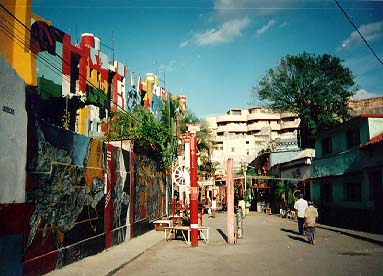
| Callejon de Hamel is a short street in Central Habana that is decorated with the murals and sculpture of the Santeria-inspired artist Salvador. It is near the intersection of Lazaro and Hospital. A little shop at the end of the streets may sell Santeria herbs in the morning, but I can't confirm this. A rumba group performs here every Sunday around noon. |
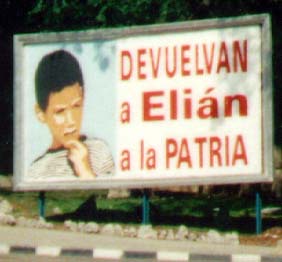
| There were many demonstrations in Habana about Elian Gonzales, the little Cuban boy the anti-Castro zealots in Miami are refusing to return to his father in Cuba. They gave out t-shirts to all the school kids, and it almost became part of the standard school uniform. I tried to get one, but they would only give them to Cubans. |
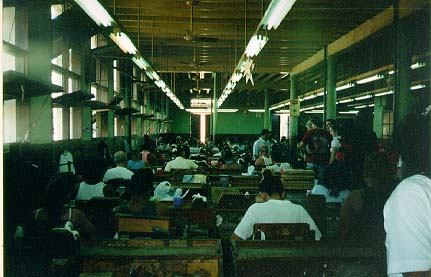
| I took the Partagas cigar factory tour. You can watch all stages of the cigar-making process. I thought the admission price of $10 was rather high, considering that you can see a pretty good musical performance and have dinner for the same price. It is also more than they pay one of their rollers in a month. |
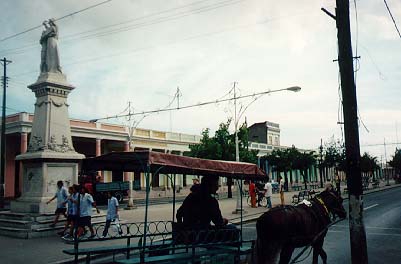
| Cienfuegos is a quiet seaside town. The architecture is French colonial, not Spanish. It has a pleasant Malecon, which extends on a skinny strip of land into the sea. Horsedrawn communal taxis cruise down the Malecon. There is a very popular disco on this strip. I don't remember the name of it, but you can't miss it. Just hang out at the Rapido, and see where everyone goes after 10pm. The Rapido seemed to be the most happening spot before the clubs open - lots of women in tight dresses and heels. I have no idea where the men were. There are certainly alternatives to the discos. There is live music and theatere in town. I also saw a great baseball game in Cienfuegos for one peso. |
I went to Remedios for the evening of December 24th to see the Paranda, a traditional annual celebration in which the two major neighborhoods of the town compete to put up the nicest float and to launch the most impressive fireworks display. Remedios is a small town, but it is packed with Cubans and tourists for this event.
The fireworks were terrifying. They went on for hours. They produced so much sulfurous smoke that my eyes stung and I couldn't see across the main square. There were three kinds of fireworks. The first are pretty much like bottle rockets, just fireworks mounted on the ends of wooden sticks. These would be launched straight up, so a few seconds later, people take cover from the rain of wooden spears. The second are these paper bags full of gunpowder with a fuse. These would be dropped into vertical metal tubes and lit with a cigar. A few seconds later the thing would hiss and fly into the sky. If done properly, it would create a terrific explosion high in the air, and the tattered remains would fall on the crowd. Often, the fuse was a bit too long, and a large bag would land hissing at your feet. Run. The third and most novel type is a thin wooden hoop with four little rockets mounted on it at angles. When they are lit, they cause the whole thing to spin then gradually take to the air. They would often only rise a couple of feet, then take off horizontally about at the level of your head. Run.
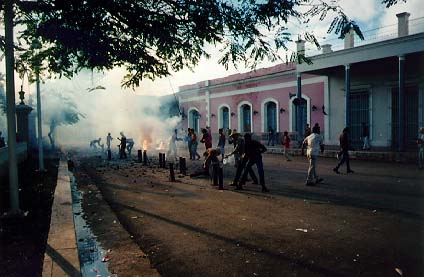
| 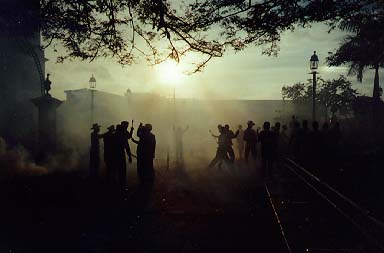
|
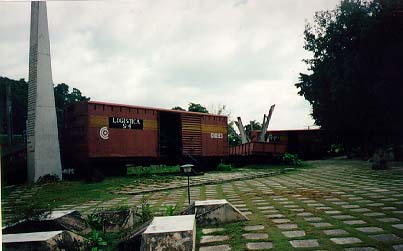
Santa Clara is the place to worship Che Guevara. There is a museum and monument, in addition to Tren Blindado (pictured), the site where Che and his allies derailed and attacked a train full of Batista's soldiers. The town has a beautiful central square, flanked by theaters and hotels. The most noteworthy hotel is the Santa Clara Libre, which still has the bullet holes inflicted by Batista's forces. The square also had a nice little open-air tesoria, where I drank lots of little infusiones de te for about 1/10 of a peso. I went to the Casa de la Cultura to see a Noches Cubano, which had a fantastic son band. One of the lead singers was an old guy who looked a bit like a singing tortoise. There were no tourists there. In fact, there were only 60+ year-old Cubans. One of them approached me, grabbed my hands and cried "La Guerre! La Guerre!" Someone explained to me that this little man thought that I was Vietnamese. The Cubans seem to love the Vietnamese, naming every other bookstore "Viet-Nam". The poshest nightspot in town is El Bosque, which has a caberet and a disco (separate entrances and cover charges). It's near the baseball field. I didn't see many foreigners in Santa Clara, which I thought was odd.

Trinidad is a beautiful colonial city close to the sea. The whole city has been named a World Heritage site, so there is much work to restore the buildings. The streets in the center are cobblestone, which is charming until you twist your ankle. The first day I was in Trinidad, I was totally irritated seeing so many tourists and so many people taking advantage of them. The next day, I calmed down and realized that the tourists were what was driving all the live traditional music around the little town. Younger Cubans throughout the country are listening to Mexican salsa and European disco music. The older ones would love to listen to the more traditional son. So there would be these places in Trinidad, notably the Casa de la Trova, filled with tourists and the occasional older Cuban (who is not required to pay the $1 cover charge). Without the tourists, many of these places would not be able to exist. So what is more "real", the discos playing Ricky Martin and Euro-pop or the touristic "Cubaland" themepark presented to the tourists? In Trinidad, I gave in and chose the themepark and saw wonderful performances. If you can, try to see the Conjunto Folklorico de Trinidad. They are a perfect Afro-Cuban music and dance troupe. For some reason, the Casa de la Trova never has trova. It only has bunches of son groups. The only trova I saw in Trinidad was in my neighbor's house.
One of the first things I asked about in Cuba was the whereabouts of the Buena Vista Social Club (the musicians, not the building). The woman I asked looked understandably puzzled, but then sang the first few bars of Compay Segundo's Chan Chan to her husband, who helped her remember Compay's name. Although most people don't know about Ry Cooder's project, lots of people know about Compay, and in touristic places you can even hear them playing the Buena Vista Social Club album. When I was in Viņales, I saw a tiny band playing several songs from that album with the mostly-Cuban crowd singing along. It makes me wonder how this album will affect Cuban music even though it has not been released there.
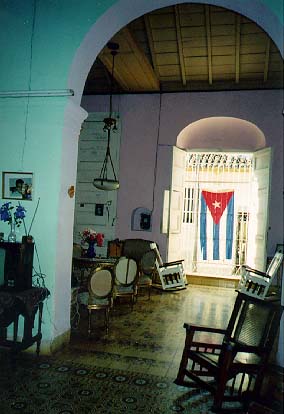
| I was quite pleased by the private home I stayed at in Trinidad. I think it was a nice house by any standard - one day, I returned to find a dozen tourists wandering around inside taking photos. Incidentally, the Cuban flag in the window was not always there. It may have been up for the independence day celebrations. Another thing that I noticed was the lack of kitschy ceramic animals, which I saw in many of the other homes I visited. |
| Unlike Habana, there does not appear to be a shortage of paint in Trinidad. The buildings are painted in typical Caribbean colors. | 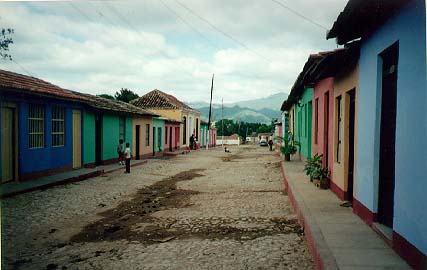
|
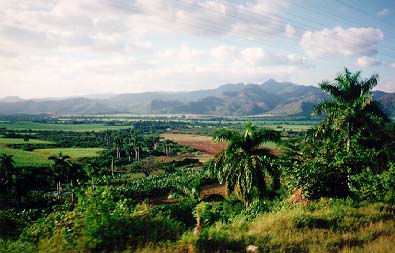
| Valle de los Ingenios, the area just north of Trinidad, is gorgeous. It is a traditional sugar-growing region. I was taking pictures out of the moving bus on my way to Trinidad, and the guy next to me told me to take one at the next turn. I did, and this is what I got. |
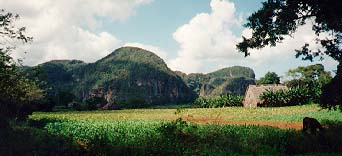
Viņales is the quiet and beautiful tobacco-growing area a couple of hours west of Habana. The area features mogotes, rounded limestone mesas covered in vegetation. The thing to do at night is visit one of two bars, the blue one and the yellow one (they have real names that tourists never use), right across the street from each other. I think they have live music nearly every night. At these bars I discovered that the mojito, one of Hemingway's favorite drinks, is actually quite strong, a fact you will not likely learn in the tourist bars in Habana where they water down the drinks and use substandard rum.
I rented a bicycle and looked at the nearby caves and tobacco fields near Viņales. One of the largest cave systems in the Americas is about 20 km away. I hear that you can also get to beautiful beaches.